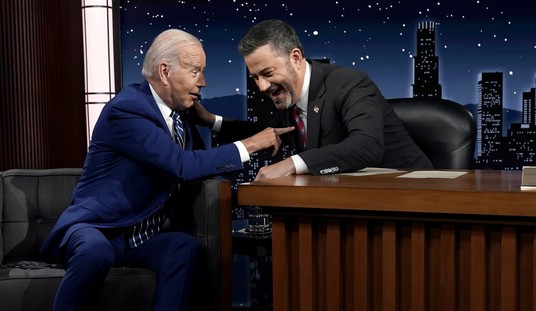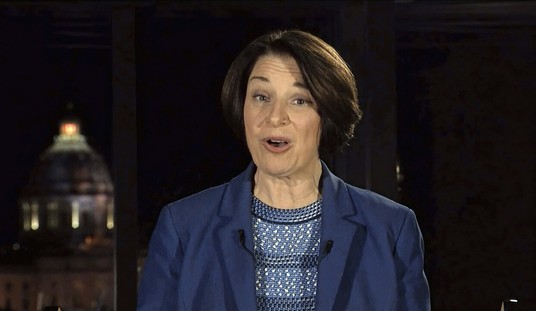A year ago today, two bombs exploded at the Boston Marathon finish line, killing three people and wounding 264 others gathered at the annual sporting event. Within days, investigators identified the two bombers and Boston ended up in a lockdown while law enforcement tried to capture them. One died in a firefight, while the other finally surrendered after the lockdown, when a local man finally had an opportunity to notice that someone had tampered with his boat in his backyard. Within a few weeks, we found out plenty about Tamerlan and Dzhokar Tsarnaev — the older brother’s lengthy trip to Dagestan, where Islamist extremists operate, and the FBI missed a couple of opportunities to identify Tamerlan as a threat.
Since then, though, we haven’t heard much about the case. Last week, the Inspector General of the combined intel community absolved the FBI for the missed opportunities, blaming the Russians for a lack of cooperation. Otherwise, the story has been largely static for months, and probably would be today if not for the anniversary. Boston commemorated the attack this morning with a rolling ceremony that emphasized hope and resilience:
On the anniversary of last year’s bombings at the Boston Marathon, this city paused Tuesday to honor those who had been killed and wounded and to demonstrate its defiance and resilience in the face of the attack.
The day began with a 7 a.m. service of “remembrance, reflection and renewal” in the chapel of Massachusetts General Hospital, one of several hospitals pressed into service last April 15 in response to the sudden carnage at the marathon finish line.
Later, on Boylston Street, with bagpipers playing “Amazing Grace,” wreaths were placed near the site of the explosions. Gov. Deval Patrick and other dignitaries stood quietly as Mayor Martin Walsh helped Jane and Henry Richard, whose 8-year-old brother Martin was killed in the bombing, place the wreaths. Jane Richard lost a leg in the explosion; her parents were also seriously hurt. The only words spoken were a prayer from Cardinal Sean P. O’Malley. …
The major tribute of the day is to take place at noon at the Hynes Convention Center on Boylston Street, not far from the finish line, where two homemade bombs last year killed three people and wounded more than 260, some of them gravely. Sixteen people had limbs amputated.
Vice President Joseph R. Biden Jr. is scheduled to speak at the tribute, as are Gov. Deval Patrick, Mayor Martin J. Walsh of Boston and Thomas M. Menino, who was mayor when the bombers struck.
But what about finding more on the Tsarnaevs — their motives, their connections, and how they managed to elude counterterrorism officials? Thomas Jocelyn wonders the same thing at The Daily Beast:
One year ago today, two backpack bombs were detonated at the Boston Marathon, killing three people. More than 260 others were wounded or maimed. In the months since, many man-hours have been spent investigating the accused perpetrators of the bombings, Tamerlan and Dzhokhar Tsarnaev. However, a key question remains unanswered: did the brothers have any substantive ties to terrorists abroad?
The extent of the confusion surrounding this basic question is troubling. Tamerlan Tsarnaev, the elder brother, is known to have traveled to Dagestan for several months in 2012. Credible press reports say that he was in contact with extremists participating in the insurgency against the Russian government there. But the U.S. government still has not provided the American public with a detailed summary of Tamerlan’s overseas contacts. And the press’s reporting does not clarify matters.
Another open question is how the police and FBI handled the manhunt. NBC reports that the police response was strong — too strong, in fact. Police fired so many rounds and in such a haphazard manner that the injuries at the initial gunfight turned out to all be friendly-fire incidents — and while the Tsarnaevs threw home-made bombs at the police, they may have fired as few as ten shots in the entire melee:
In effect, the suspects ended up at the center of a ring of cops on Laurel Street between Dexter and School streets during the 20-minute firefight, and the bullets that were fired at them often hit near the officers on the other side.
“Certainly not a good idea,” said Davis. “They see somebody shooting, so they fire at them. That’s their training.”
Police training dictates that officers consider several key factors when making the decision to fire their weapons. They must assess the danger posed to bystanders, residents and fellow officers, they should know the position of fellow officers and they should stop to reassess the situation if they can, rather than simply continuing to pull the trigger.
But on Laurel Street, rounds flew into parked cars and police vehicles and chewed up fences and trees. A round entered the home of Andrew Kitzenberg on the north side of the street and lodged in a chair. Another ripped through the exterior wall of Adam Andrew and Megan Marrer’s house and landed on their living room floor.
More than a dozen officers suffered minor injuries during the mayhem, but none was believed to have been wounded by the suspects. The only serious wound was suffered by Richard Donohue, a transit cop with the Massachusetts Bay Transportation Authority, who was hit in the groin by a police bullet and began to bleed profusely.
The big problem was a flood of volunteer off-duty officers who did not get clear leadership and direction in either of the two standoffs. The second, where the younger Tsarnaev hid in the boat, turned into a one-sided hail of bullets based on a misunderstanding and a lack of direct control:
The commander on scene was able to deploy the tactical team and establish a perimeter, says the report, but his control was only partial because there were so many extra, “self-deployed” bodies arriving. …
At around 7 p.m., a voice on the police radio issued a warning, “There’s a perp in the boat trying to poke a hole in the liner, a perp in the boat. Live party who may be trying to object out, live party in the boat confirmed.”
Tsarnaev was pushing a long, thin object up through the boat covering. The object later turned out to be a fishing gaff, which Tsarnaev may have been trying to use to push up the tarp so he could see out.
But one of the snipers on the roof saw the object and began shooting. It sparked a round of what is known as “contagious fire,” where other officers with their fingers on the trigger began peppering the boat with bullets.
The commander began shouting for the officers to cease fire, but the fusillade went on for 10 seconds. Hundreds of rounds were expended.
In fairness, this was a truly exceptional set of circumstances, and the main goal on everyone’s mind was to stop these two before they could launch another attack. No one knew what the Tsarnaevs had in their car (and they did have more bombs, used in the firefight), or what Dzhokar had in the boat, either. The volunteerism demonstrated by police should be hailed, as they selflessly put themselves in the way of two terrorists. But what this does show is the need to have tight control over armed and deployed forces, even those trained to respond to such crises.
Meanwhile, the younger brother awaits trial, which has been tentatively scheduled for November. It may depend on whether his defense team offers an insanity plea, which would be a big long shot, given the obvious attempts to get away and to fight off the police. Bloomberg News discusses the status of the trial, and also an interesting system put in place for the Boston Marathon and beyond — a surveillance system that constantly looks for “behaviors” in street crowds and mass transit systems:
We eventually might want some answers about that system, too.







Join the conversation as a VIP Member